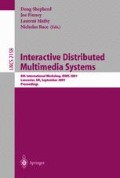Abstract
MPEG [1] has been responsible for the successful MPEG-1 and MPEG-2 standards that have given rise to widely adopted commercial products and services, such as Video-CD, DVD, digital television, digital audio broadcasting (DAB) and MP3 (MPEG-1 Audio layer 3) players and recorders. More recently, the MPEG-4 standard [2] is aimed to define an audiovisual coding standard to address the emerging needs of the communication, interactive and broadcasting service models as well as of the mixed service models resulting from their technological convergence. The MPEG-4 object-based representation approach where a scene is modeled as a composition of objects, both natural and synthetic, with which the user may interact, is at the heart of the MPEG-4 technology. With this new coding approach, the MPEG-4 standard opens new frontiers in the way users will play with, create, re-use, access and consume audiovisual content. Following the same vision underpinning MPEG-4, MPEG initiated after another standardization project addressing the problem of describing multimedia content to allow the quick and efficient searching, processing and filtering of various types of multimedia material: MPEG-7 [3]. The need for a powerful solution for quickly and efficiently identifying, searching, filtering, etc., various types of multimedia content of interest to the user, human or machine, using also non text-based technologies, directly follows from the urge to efficiently use the available multimedia content and the difficulty of doing so.
The need for any standard comes from a very essential requirement relevant for all applications involving communication between two or more parts: interoperability. Interoperability is thus the requirement expressing the user’s dream of exchanging any type of information without any technical barriers, in the simplest way. Without a standard way to perform some of the operations involved in the communication process and to structure the data exchanged, easy interoperability between the terminals involved would be impossible. Having said that, it is clear that a standard should specify the minimum number of tools to guarantee interoperability since it is important that as many as possible non-normative technical zones exist, to allow the incorporation of technical advances, and thus to increase the life time of the standard, as well as to stimulate the industrial technical competition. The existence of a standard has also important economical implications since it allows the sharing of costs and investments and the acceleration of applications’ deployment.
Following the development of the standards mentioned above, MPEG acknowledged the lack of a “big picture” describing how the various elements building the infrastructure for the deployment of multimedia applications relate to each other or even if there are missing open standard specifications for some of these elements. To address this problem, MPEG started the MPEG-21 project [4], formally called “Multimedia framework” with the aim to understand if and how these various elements fit together, and to discuss which new standards may be required, if gaps in the infrastructure exist. Once this work has been carried out, new standards will be developed for the missing elements with the involvement of other bodies, where appropriate, and finally the existing and novel standards will be integrated in the MPEG-21 multimedia framework. The MPEG-21 vision is thus to define an open multimedia framework to enable the transparent and augmented delivery and consumption of multimedia resources across a wide range of networks and devices used by different communities. The MPEG-21 multimedia framework will identify and define the key elements needed to support the multimedia value and delivery chain, as well as the relationships between and the operations supported by them. This open framework guarantees all content creators and service providers equal opportunities in the MPEG-21 enabled open market. This will also be to the benefit of the content consumers who get access to a large variety of content in an interoperable manner.
This presentation will not only describe the technical objectives of the MPEG-21 standard but also its motivation and vision. Why it is important to have an open standard multimedia framework? To whom is essential this type of standard? What will be lost if MPEG-21 does not succeed?
Access this chapter
Tax calculation will be finalised at checkout
Purchases are for personal use only
References
MPEG Home Page, http://www.cselt.it/mpeg/
F. Pereira, “MPEG-4: why, what, how and when?”, Tutorial Issue on the MPEG-4 Standard, Signal Processing: Image Communication, vol. 15, n∮ 4–5, December 1999
R. Koenen, F. Pereira, “MPEG-7: a standardised description of audio-visual content”, Special Issue on MPEG-7 Technology, Signal Processing: Image Communication, vol. 16, n∮ 1–2, September 2000
MPEG Requirements Group, “MPEG-21 overview”, Doc. ISO/MPEG N4041, MPEG Singapore Meeting, March 2001
Author information
Authors and Affiliations
Editor information
Editors and Affiliations
Rights and permissions
Copyright information
© 2001 Springer-Verlag Berlin Heidelberg
About this paper
Cite this paper
Pereira, F. (2001). The MPEG-21 Standard: Why an Open Multimedia Framework?. In: Shepherd, D., Finney, J., Mathy, L., Race, N. (eds) Interactive Distributed Multimedia Systems. IDMS 2001. Lecture Notes in Computer Science, vol 2158. Springer, Berlin, Heidelberg. https://doi.org/10.1007/3-540-44763-6_23
Download citation
DOI: https://doi.org/10.1007/3-540-44763-6_23
Published:
Publisher Name: Springer, Berlin, Heidelberg
Print ISBN: 978-3-540-42530-4
Online ISBN: 978-3-540-44763-4
eBook Packages: Springer Book Archive

